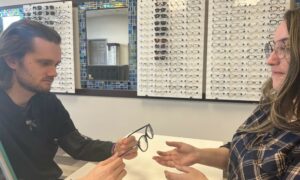
Feb. 3, 2016
The durability of eyewear, and offering a good warranty policy, could make a difference in selling eyewear for children of all ages, Jobson Optical Research’s 2015 Selling Eyewear to Children survey of ECPs suggests. Some 90.9 percent of respondents say “durable construction” is “very important” when selling eyewear to parents of children ages 0-3, while 81.1 percent of respondents say a good warranty is considered “very important” for selling eyewear for children in this age group. Some 88.2 percent say durable construction is very important to parents of children ages 4-8, and good warranty policy was considered by 79.5 percent to be very important for the 4-8 age group.
For tweens and teens, a good warranty policy becomes more important than durability. For parents of “tweens,” ages 9-13, 71.2 percent of respondents say a good warranty policy is very important, while 70.1 percent say durable construction is very important. For teens, ages 14-17, 61.6 percent say a good warranty policy is very important, while 53.4 percent say durable construction is very important.
Click HERE to purchase Jobson Optical Research’s 2015 Selling Eyewear to Children report.
We used to say a happy patient will tell three others and an unhappy patient will tell 13 others. Now, with social media, an unhappy patient will tell 3 million others. It’s worth our effort to explore reasons that could result in an unhappy patient. One of the areas where this often happens is when the practice warranty, or replacement plan, does not meet the patient’s expectations.
The purpose of a warranty, or a replacement plan, is to lower the barrier to purchase. If your policy is “all sales are final,” fewer people will step over that high barrier to purchase than if your policy is a “100% guarantee.” There are 12 possible reasons resulting in patients returning a new pair of glasses, or contact lenses, and potentially becoming an unhappy patient.
1) The prescription is incorrect.
2) Incorrect measurements.
3) The wrong lens design was chosen.
4) The item has a manufacturer’s defect.
5) The patient cannot adapt.
6) The new glasses are too heavy.
7) The new glasses are too fragile for the patient’s lifestyle.
8) The new frame, or the new lenses, are cosmetically a problem.
9) The patient has a medical condition causing frequent prescription changes.
10) Accidents.
11) Abuse.
12) Buyers remorse.
Clearly, reasons 1-4 above are going to be fixed because it is the right thing to do. Additionally, the Uniform Commercial Code (UCC) backs up this idea by declaring if an item is broken at purchase, the buyer should receive a full cash refund. When this happens, do you also give the patient something extra for the service problem they are experiencing?
Reasons 5-8 are subjective. A careful history should explore questions such as “What have you tried before that did not work?” and “Who else needs to be included in this buying decision?” If you are dealing with a patient in a relationship with another person, at the very least, take a picture of the new frame on the patient and send it to the significant other for approval before ordering.
Reason 9 is a special case. If the patient is an uncontrolled diabetic, or a rapidly growing child, then your practice should have a policy on how to handle this situation. Your policy should be explained to the patient upfront before the patient returns needing a new prescription, or a larger frame, when just a few weeks or months have passed.
Reasons 10 -12 are out of our control. The dog finishes off the homework and turns its attention to the new glasses. The patient wants to see how far the frame will bend before breaking and, surprise, actually breaks the frame. The patient trips in a parking lot and sends the glasses sliding–lenses down–across the asphalt. Stuff happens.
How do we handle it? Some practices sell warranties, or replacement plans, covering these situations and others don’t. How is this handled in your practice?
Managing buyer’s remorse starts in the office during the original exam. In today’s world, no one makes a buying decision without having to justify it to someone else. The key is to give the patient enough education to justify the purchase. The patient expectation is that all glasses containing the doctor’s new prescription are the same. Nothing could be further from the truth, but the patient does not know that. Make sure it is explained to the patient in the exam room and in the optical that the new glasses have three components that comprise the new prescription: (1) the doctor’s new prescription, (2) the design of how the prescription will go into the lenses and (3) the manufacturing process (newest technology). The bottom line is to educate patients.
The key concept in this entire discussion is keeping the patient happy. How far are you willing to go? Whatever your polices, make sure patients are educated upfront to help manage patient expectations that may be different from what your actual policies are. Unhappy patients tell others.
Even if you have to pay more to fix a problem than what the patient originally paid, consider this a marketing expense. You are attempting to go the extra mile to help manage the damage to your practice an unhappy patient may do on social media.
Take this week to review the warranty and replacement policies in your office and how they are presented to patients.























